House of Wettin
| House of Wettin German: Haus Wettin | |
|---|---|
| Royal family | |
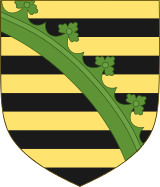 | |
| Country |
|
| Estates | Wettin Castle (main; Wettin) |
| Titles | |
| Style(s) |
"His/Her Majesty" "His/Her Imperial and Royal Highness" |
| Founded | 900 |
| Founder | Theodoric I |
| Final ruler |
Saxony: Frederick Augustus III Bulgaria: Simeon II Portugal: Manuel II Warsaw: Frederick Augustus I |
| Current head | Michael, Prince of Saxe-Weimar-Eisenach |
| Deposition |
Saxony: 1918 Bulgaria: 1946 Portugal: 1910 Warsaw: 1815 |
| Ethnicity | German |
| Cadet branches | |
The House of Wettin is a dynasty of German counts, dukes, prince-electors and kings that once ruled territories of present-day German states of Saxony and Thuringia for 953 years. The royal house is one of the oldest of Europe. Its origins can be traced back to the town of Wettin, Saxony-Anhalt. The Wettins gradually rose to power within the Holy Roman Empire. Members of the royal family became the monarchs of several medieval states, starting with Saxon Eastern March in 1030. Other states they gained were Meissen in 1089, Thuringia in 1263 and Saxony in 1423.
The family divided into two ruling branches in 1485 by Treaty of Leipzig: the Ernestine and Albertine branches. The older Ernestine branch played a key role during the Protestant Reformation. Many ruling monarchs outside Germany were later tied to its cadet branch Saxe-Coburg and Gotha. The Albertine branch, while less prominent, ruled the most of Saxony and played a part in Polish history.
Agnates of the House of Wettin have, at various times, ascended the thrones of Great Britain, Portugal, Bulgaria, Poland, Saxony, and Belgium. Only the British and Belgian lines retain their thrones today.
Origins: Wettin of Saxony
The oldest member of the House of Wettin who is known for certain is Theodoric I of Wettin, also known as Dietrich, Thiedericus, and Thierry I of Liesgau (died c. 982). He was most probably based in the Liesgau (located at the western edge of the Harz). Around 1000, the family acquired Wettin Castle which was originally built by the local Slavic tribes ( See Sorbs), after which they named themselves. Wettin Castle is located in Wettin in the Hassegau (or Hosgau) on the Saale River. Around 1030, the Wettin family received the Eastern March as a fief.[1]
The prominence of the Wettins in the Slavic Saxon Eastern March (or Ostmark) caused Emperor Henry IV to invest them with the March of Meissen as a fief in 1089. The family advanced over the course of the Middle Ages: in 1263 they inherited the landgraviate of Thuringia (although without Hesse), and in 1423 they were invested with the Duchy of Saxony, centred at Wittenberg, thus becoming one of the prince-electors of the Holy Roman Empire.
Ernestine and Albertine Wettins
The family divided into two ruling branches in 1485 after being under control from Charles IV King of Bohemia and Holy Roman Emperor, the sons of Frederick II, Elector of Saxony, divided the territories hitherto ruled jointly. The elder son Ernest, who had succeeded his father as Prince-elector, received the territories assigned to the Elector (Electorate of Saxony) and Thuringia, while his younger brother Albert obtained the March of Meissen, which he ruled from Dresden. As Albert ruled under the title of "Duke of Saxony", his possessions were also known as Ducal Saxony.
 Ernest, Elector of Saxony (1441–1486)
Ernest, Elector of Saxony (1441–1486) Albert, Duke of Saxony (1443–1500)
Albert, Duke of Saxony (1443–1500)
Ernestines
The older Ernestine branch remained predominant until 1547 and played an important role in the beginnings of the Protestant Reformation. Frederick III (Friedrich der Weise) appointed Martin Luther (1512) and Philipp Melanchthon (1518) to the University of Wittenberg, which he had established in 1502.[2]
The Ernestine's predominance ended in the Schmalkaldic War (1546/7), which pitted the Protestant Schmalkaldic League against the Emperor Charles V. Although itself Lutheran, the Albertine branch rallied to the Emperor's cause. Charles V had promised Moritz the rights to the electorship. After the Battle of Mühlberg, Johann Friedrich der Großmütige, had to cede territory (including Wittenberg) and the electorship to his cousin Moritz. Although imprisoned, Johann Friedrich was able to plan a new university. It was established by his three sons on 19 March 1548 as the Höhere Landesschule at Jena. On 15 August 1557, Emperor Ferdinand I awarded it the status of university.[2]
The Ernestine line was thereafter restricted to Thuringia and its dynastic unity swiftly crumbled, dividing into a number of smaller states, the Ernestine duchies. Nevertheless, with Ernst der Fromme, Duke of Saxe-Gotha (1601–1675), the house gave rise to an important early-modern ruler who was ahead of his time in supporting the education of his people and in improving administration. In the 18th century, Karl August, Duke of Saxe-Weimar-Eisenach, established what was to become known as Weimar Classicism at his court in Weimar, notably by bringing Johann Wolfgang von Goethe there.[2]
It was only in the 19th century that one of the many Ernestine branches, the House of Saxe-Coburg and Gotha, regained importance through marriages as the "stud of Europe", by ascending the thrones of Belgium (in 1831), Portugal (1853–1910), Bulgaria (1908–1946) and the United Kingdom (in 1901).
| Electors of Saxony | ||||
|---|---|---|---|---|
| Image | Name | Began | Ended | Notes |
 |
Frederick I Friedrich I |
6 January 1423 | 4 January 1428 | Nicknamed "the Warlike." After the Wittenberg line of the House of Ascania became extinct, the Electorate was given to Frederick, Margrave of Meissen and Landgrave of Thuringia, of the House of Wettin. |
 |
Frederick II Friedrich II |
4 January 1428 | 7 September 1464 | Nicknamed "the Gentle". Son of Frederick I. Ruled jointly in Saxony with his brothers, but was the sole holder of the Electorate. Father of Ernest and Albert, founders of the Ernestine (continuing below) and Albertine Saxon lines (see Albertine Dukes of Saxony). |
| Ernestine line | ||||
 |
Ernest Ernst |
7 September 1464 | 26 August 1486 | Son of Frederick II, divided Saxony with his brother Albert, taking Wittenberg, northern Meissen, and southern Thuringia. Inherited Thuringia in 1482 and ruled it jointly with Albert until 1485. |
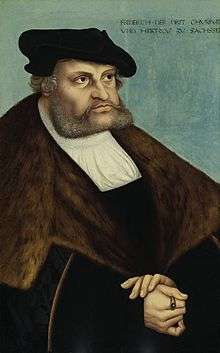 |
Frederick III Friedrich III |
26 August 1486 | 5 May 1525 | Nicknamed der Weise (the Wise). Son of Ernest. Protector of Martin Luther, but a lifelong Catholic. |
 |
John Johann |
5 May 1525 | 16 August 1532 | Nicknamed der Beständige (the Steadfast). Brother of Frederick III. Legally established Lutheranism in his territories in 1527. |
 |
John Frederick I Johann Friedrich I |
16 August 1532 | 19 May 1547 | Nicknamed der Großzügige (the Magnanimous). Son of John the Steadfast. Deprived of his Electorate by Emperor Charles V for his role in the Schmalkaldic War. Died 1554. |
Albertines

The Albertine Wettin maintained most of the territorial integrity of Saxony, preserving it as a significant power in the region, and using small appanage fiefs for their cadet branches, few of which survived for significant lengths of time. The Ernestine Wettin, on the other hand, repeatedly subdivided their territory, creating an intricate patchwork of small duchies and counties in Thuringia.
The junior Albertine branch ruled as Electors (1547–1806) and Kings of Saxony (1806–1918) and also played a role in Polish history: two Wettin were Kings of Poland (between 1697–1763) and a third ruled the Duchy of Warsaw (1807–1814) as a satellite of Napoleon. After the Napoleonic Wars, the Albertine branch lost about 40% of its lands, however the economically less developed northern parts of the old Electorate of Saxony, to Prussia, restricting it to a territory coextensive with the modern Saxony (see Final Act of the Congress of Vienna Act IV: Treaty between Prussia and Saxony 18 May 1815). Frederick Augustus III lost his throne in the German Revolution of 1918.
The present head of the Albertine "House of Saxony" is his great-grandson Prince Ruediger of Saxony, Duke of Saxony, Margrave of Meissen (born 23 December 1953). The headship of Prince Rüdiger is however contested by his second cousin, Alexander (born 1954), son of Roberto Afif, later by change of name Mr Gessaphe, and Princess Maria Anna of Saxony, a sister of the childless former head of the Albertines, Maria Emanuel, Margrave of Meissen (died 2012) who had adopted his nephew, granting him the name Prince of Saxony, contrary to the rules of male descent under the Salic Law. The dispute is detailed in the article Line of succession to the former Saxon thrones.
Albertine Electors and Kings of Saxony
| Image | Name (Life Dates) |
Relation with predecessor | Title |
|---|---|---|---|
 |
Albert III, Duke of Saxony (1443–1500) |
second son of Frederick II, Elector of Saxony | Margrave of Meissen and Duke of Saxony |
 |
George, Duke of Saxony (1471–1539) |
Son of the previous | Margrave of Meissen and Duke of Saxony |
 |
Henry IV, Duke of Saxony (1473–1541) |
Brother of the previous | Margrave of Meissen and Duke of Saxony |
 |
Maurice, Elector of Saxony (1521–1553) |
Son of the previous | Margrave of Meissen and Duke of Saxony, from 1547 Elector of Saxony. Second cousin of John Frederick, his Ernestine predecessor as Elector; grandson of Albert. Though a Lutheran, allied with Emperor Charles V against the Schmalkaldic League. Gained the Electorate for the Albertine line in 1547 after Charles V's victory at the Battle of Mühlberg. |
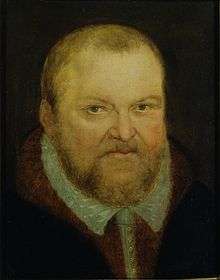 |
Augustus, Elector of Saxony (1526–1586) |
Brother of the previous | Elector of Saxony; recognized as Elector by the ousted John Frederick in 1554. |
 |
Christian I, Elector of Saxony (1560–1591) |
Son of the previous | Elector of Saxony |
.jpg) |
Christian II, Elector of Saxony (1583–1611) |
Son of the previous | Elector of Saxony |
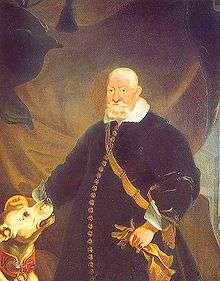 |
John George I, Elector of Saxony (1585–1656) |
Brother of the previous | Elector of Saxony; ruled during the Thirty Years' War, during which he was at times allied with the Emperor and at times with the King of Sweden. |
 |
John George II, Elector of Saxony (1613–1680) |
Son of the previous | Elector of Saxony |
| John George III, Elector of Saxony (1647–1691) |
Son of the previous | Elector of Saxony | |
 |
John George IV, Elector of Saxony (1668–1694) |
Son of the previous | Elector of Saxony |
 |
Augustus II the Strong (1670–1733) |
Brother of the previous | Elector of Saxony (as Frederick Augustus I) and King of Poland (as Augustus II). The first Albertine ruler since Luther's time to become a Roman Catholic, in order to gain the Polish throne (with the Albertines remaining Catholics ever since). Took the Polish crown 1697, opposed by Stanisław Leszczyński 1704, forced to renounce the throne 1706, returned as monarch 1709 until his death. A patron of the arts and architecture, the most prominent of all Albertine Wettins amassed an impressive art collection and built lavish baroque palaces at and around Dresden and Warsaw. |
 |
Augustus III of Poland (1696–1763) |
Son of the previous | Elector of Saxony (as Frederick Augustus II) and King of Poland (as Augustus III); converted to Catholicism 1712. King of Poland 1734–1763. Called ""the Fat" or (in Poland) "the Saxon". A weak ruler but an important art collector. |
 |
Frederick Christian, Elector of Saxony (1722–1763) |
Son of the previous | Elector of Saxony |
 |
Frederick Augustus I of Saxony (1750–1827) |
Son of the previous | Elector of Saxony, 1806 King of Saxony. His Electorate ceased with the fall of the Holy Roman Empire in 1806, and he became King of Saxony. Called "the Just". |
 |
Anthony of Saxony (1755–1836) |
Brother of the previous | King of Saxony |
 |
Frederick Augustus II of Saxony (1797–1854) |
Nephew of the previous | King of Saxony |
 |
John of Saxony (1801–1873) |
Brother of the previous | King of Saxony |
.jpg) |
Albert of Saxony (1828–1902) |
Son of the previous | King of Saxony |
 |
George, King of Saxony (1832–1904) |
Brother of the previous | King of Saxony |
 |
Frederick Augustus III of Saxony (1865–1932) |
Son of the previous. | The last king of Saxony. Lost his throne in the German revolution of 1918. |
Residences of the Albertine branch
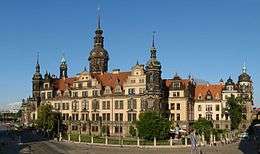
 Meissen (near Dresden)
Meissen (near Dresden).jpg) Moritzburg Castle (near Dresden)
Moritzburg Castle (near Dresden) Pillnitz Castle (near Dresden)
Pillnitz Castle (near Dresden).jpg) Weesenstein Castle (near Dresden)
Weesenstein Castle (near Dresden) Freudenstein Castle at Freiberg
Freudenstein Castle at Freiberg
- Hubertusburg Castle (near Leipzig)
The House of Saxe-Coburg and Gotha
The senior Ernestine branch lost the electorship to the Albertine in 1547, but retained its holdings in Thuringia, dividing the area into a number of smaller states. One of the resulting Ernestine houses, known as Saxe-Coburg-Saalfeld until 1826 and Saxe-Coburg and Gotha after that, went on to contribute kings of Belgium (from 1831) and Bulgaria (1908–1946), as well as furnishing husbands to queens regnant of Portugal (Prince Ferdinand) and the United Kingdom (Prince Albert). As such, the British and Portuguese thrones became possessions of persons who belonged to the House of Wettin.
From King George I to Queen Victoria, the British Royal family was variously called House of Hanover, being a junior branch of the House of Brunswick-Lüneburg and thus part of the dynasty of the Guelphs. In the late 19th century, Queen Victoria charged the College of Heralds in England to determine the correct personal surname of her late husband, Prince Albert of Saxe-Coburg and Gotha—and, thus, the proper surname of the royal family upon the accession of her son. After extensive research they concluded that it was Wettin, but this name was never used, either by the Queen or by her son or grandson, King Edward VII and King George V; they were simply called 'Saxe-Coburg-Gotha'.
Severe anti-German sentiment during World War I led some influential members of the public quietly to question the loyalty of the Royal Family, because they had a German or German-sounding name. Advisors to King George V again searched for an acceptable surname for the British royal family, but Wettin was rejected as "unsuitably comic". By Order in Council, the name of the British royal family was legally changed to Windsor.
 Veste Coburg, ancestral seat of the House of Saxe-Coburg
Veste Coburg, ancestral seat of the House of Saxe-Coburg Ehrenburg Palace, Coburg (summer residence)
Ehrenburg Palace, Coburg (summer residence) Friedenstein Castle, Gotha (winter residence)
Friedenstein Castle, Gotha (winter residence)- Reinhardsbrunn Castle, Gotha
 Rosenau Castle, Coburg
Rosenau Castle, Coburg
Branches and titles of the House of Wettin and its agnatic descent
Early Wettins
- Counts of Wettin
- Margraves of Landsberg
- Margraves of Meissen
- Margraves of Lusatia
- Dukes of Saxony, Landgraves of Thuringia
- Electors of Saxony and Arch-Marshals of the Holy Roman Empire
 Wartburg near Eisenach (1250–1406 residence of the Wettins)
Wartburg near Eisenach (1250–1406 residence of the Wettins)
Albertines
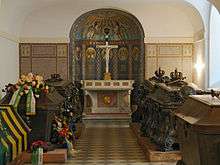
- Margraves of Meissen
- Electors of Saxony and Arch-Marshals of the Holy Roman Empire (1547–1806)
- Kings of Poland and Grand Dukes of Lithuania
- Kings of Saxony (1806–1918), currently Prince/Princess of Saxony, Duke/Duchess of Saxe, the head of the House also Margrave of Meissen
Extinct Albertines

 Merseburg Castle
Merseburg Castle- Neu-Augustusburg Castle, Weißenfels
Ernestines
- Electors of Saxony and Arch-Marshals of the Holy Roman Empire (1464–1547)
 Wittenberg Castle, residence of Frederick III, "the Wise", built 1490–96
Wittenberg Castle, residence of Frederick III, "the Wise", built 1490–96- Hartenfels Castle in Torgau, main residence of the Ernestine Electors since Frederick III, "the Wise", built 1533–40
Extinct Ernestines
- Dukes of Saxe-Coburg
- Dukes of Saxe-Coburg-Saalfeld
- Dukes of Saxe-Altenburg (first line of Altenburg)
- Dukes of Saxe-Gotha-Altenburg (second line of Altenburg)
- Dukes of Saxe-Hildburghausen, then Dukes of Saxe-Altenburg (third line of Altenburg)
- Dukes of Saxe-Weimar
- Dukes of Saxe-Eisenach
- Dukes of Saxe-Coburg-Eisenach
- Dukes of Saxe-Jena
- Dukes of Saxe-Gotha
- Dukes of Saxe-Eisenberg
- Dukes of Saxe-Marksuhl
- Dukes of Saxe-Römhild
- Kings of Portugal (House of Braganza-Saxe-Coburg and Gotha)
Existing Ernestines
- Grand Dukes of Saxe-Weimar-Eisenach
- Dukes of Saxe-Meiningen
- Dukes of Saxe-Coburg and Gotha (House of Saxe-Coburg and Gotha)
- Kings and Queen of the United Kingdom (House of Windsor, originally House of Saxe-Coburg and Gotha)
- Kings of Bulgaria (House of Saxe-Coburg and Gotha, sometimes known as "Sakskoburggotski")
- Kings of the Belgians (House van België or de Belgique or von Belgien, "of Belgium", originally House of Saxe-Coburg and Gotha)

 Duchy of Saxe-Coburg and Gotha
Duchy of Saxe-Coburg and Gotha.jpg)
.png)
Residences of Ernestine branches
- Altenburg Castle
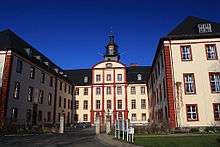 Saalfeld Castle
Saalfeld Castle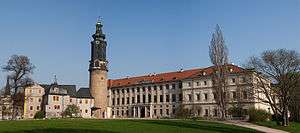 Schloss in Weimar
Schloss in Weimar Eisenach Palace
Eisenach Palace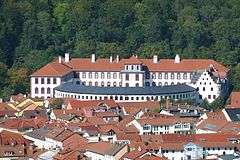 Elisabethenburg Palace in Meiningen
Elisabethenburg Palace in Meiningen- Hildburghausen Castle
Coats of arms
 Counts of Wettin, Margraves of Landsberg
Counts of Wettin, Margraves of Landsberg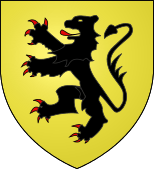 Margraves of Meissen
Margraves of Meissen Margraves of Meissen and Landgraves of Thuringia
Margraves of Meissen and Landgraves of Thuringia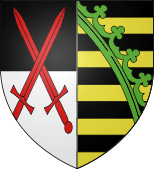 Elector of Saxony and Arch-Marshal of the Holy Roman Empire
Elector of Saxony and Arch-Marshal of the Holy Roman Empire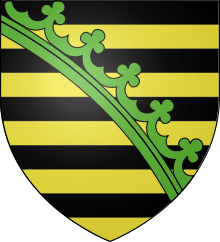 King of Saxony (standard arms)
King of Saxony (standard arms)
For an extensive treatment of the coats of arms, see: Coat of arms of Saxony
or in French: Armorial de la maison de Wettin
See also
- Rulers of Saxony, a list containing many Wettins
- Wettin, Saxony-Anhalt, the city from which the Wettin dynasty originated
References
- ↑ Lexikon des Mittelalters, vol. IX, col. 50, Munich 1969–1999
- 1 2 3 Kellner, Stefanie (February 2016). "Die freiheitliche Geisteshaltung der Ernestiner prägte Europa". Monumente (in German). pp. 9–16. Retrieved 16 February 2016.
External links
| Wikimedia Commons has media related to House of Wettin. |
- Timeline at the website of the State of Saxony.
- Website of the 2016 Landesaustellung of Thuringia on the Ernestine dynasty
- Official website of the current Margrave of Meissen
- Website of the House of Wettin (German)
- 2nd official website of the House of Wettin (German)
- Online Gotha

.png)